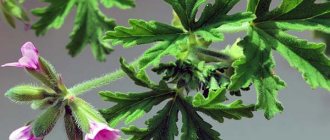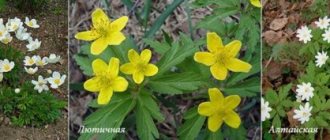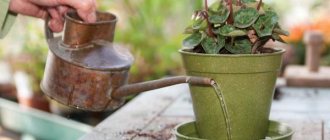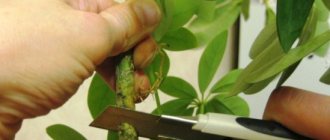Geranium (pelargonium) is now at the peak of popularity. Many gardeners love it for its ease of care and beautiful flowering. Pelargonium loves good lighting. In autumn and winter, daylight hours decrease, which negatively affects the plant. The geranium stretches out, the shoots reach towards the light and the bush loses its attractiveness. Experienced flower growers know this and without fail trim their pets in the autumn. In this article we will tell you when and how to prune geraniums for the winter.
Timing of the procedure for pelargonium 2. Why does geranium need pruning 3. Instructions for pruning the flower 4. Recommendations for pruning different types of geranium 5. Caring for the flower after the procedure
Photo by O. Nikonorova: Follow the rules when carrying out the procedure.
Need for pruning
Pelargonium is pruned regularly; the choice of season (spring or autumn) is determined by flowering time and variety. This is necessary for:
- obtaining fresh shoots;
- variety propagation;
- formation of an even and dense crown;
- improving air exchange.
At the same time, old dry branches, shoots growing in the direction of the stem and interfering with each other, branches that lack foliage and inflorescences are removed.
Autumn pruning is more reasonable than spring pruning. At this time, the geranium is preparing to rest. The process prepares it, facilitates wintering, and promotes lush flowering in summer.
Why prune geraniums - purpose and timing of the procedure
There are many types and varieties: garden and indoor flowers - pelargoniums, ampelous and bush geraniums, plants with climbing or erect shoots. In addition, there is a huge variety of color and splendor of inflorescences. And each of them needs formative pruning, the purpose of which, first of all, is to create a dense bush and stimulate lush flowering.
Without outside intervention, geranium never sends out additional lateral shoots - this is its peculiarity. At each node there are growth buds, but they are all in a state of rest. In order to make the plant look like a lush bush, it is necessary to provoke the development of branches and thickening of the green part of the flower.
The formation of geraniums should be carried out on a regular basis, and it is recommended to begin this process immediately after purchasing or propagating a flower and transplanting it into a permanent pot.
The stems of the plant should not be allowed to become excessively elongated and exposed. If this happens, there are only 2 options left:
- Or completely trim the bush in the fall after flowering and root the cut cuttings in order to obtain new young plants.
- Or cut off the stems of the flower, leaving only the strongest and healthiest one, from which all lower side shoots should be removed. The stem can be shortened a little, and then, after some time, the geranium will form like a small tree on a thick trunk. A stem that is too tall needs to be pruned, removing part of the top, then with the development of lateral buds, the crop will turn into a small tree on the trunk. It looks incredible when in bloom.
The timing for pruning geraniums is early spring and autumn. Moreover, a heavily pruned geranium in the spring may not have time to regain its strength for flowering, so all manipulations associated with stress for the plant should be carried out as early as possible - around the end of February - beginning of March . Considering that pinching is a less traumatic procedure, in the spring, if there is no urgent need for pruning, you can stop at it.
Winter pruning is carried out immediately after autumn flowering, when the last petals have fallen from the plant. If geranium is planted in open ground in the summer or constantly grows in a garden bed, then in the fall its stem is cut exactly in half - this significantly improves air exchange in the crown, the lower leaves become accessible to the sun's rays.
Geranium pruning technology
When cutting, use a blade or a utility knife. When using scissors, they bend the shoot, causing damage to the tissue. Before starting, the instruments are treated so that infection does not enter the fresh cut. Remove old dried branches or densely overgrown shoots. The cut is made above the knot that faces outward. This is necessary so that fresh shoots grow and do not interfere with each other. After the procedure, it is sprinkled with antiseptics: charcoal, ash; in room conditions, cinnamon powder is used to disinfect and protect against pests.
To accelerate growth, the plant is fed with fertilizer containing nitrogen.
What to do if a mistake is made?
The most common mistakes that gardeners make when pruning geraniums:
- Violation of deadlines. Strict adherence to plant pruning deadlines is a necessary condition. Due to the procedure, the inflorescences will begin to fall off in winter.
- Incorrect trim level. If you prune high above a leaf node, the excess part of the stem will dry out, which may result in the death of the entire shoot.
- Radical pruning. If too many shoots are removed at one time, the plant will stop growing and flowering, recovering from the resulting stress.
- Too frequent pruning will slow down the development of new buds.
Advice: The main rule when pruning geraniums is to comply with the deadlines for completing the procedure. If the geranium is pruned incorrectly, it is necessary to provide the plant with good care and provide it with the optimal level of watering, fertilizing and lighting. Do not disturb the plant and give it time to recuperate. Recommended reading for geranium lovers:
- Is it possible to replant a flowering one and how to care for the plant after the procedure?
- Geranium blooms, but the leaves do not grow - why does this happen and how to avoid it?
How to form pelargonium in the fall
After the end of summer, flower growers prepare the flower for wintering. Geraniums are pruned between September and November, after the last bud has dried. During this period, dry yellowed leaves, branches with no foliage and weak shoots stand out. The main stem is shortened by one third, fresh cuts are sprinkled with antiseptics.
If winter buds appear on the flower, they are removed. From late November to March the plant is dormant.
Watering
Probably, after looking at the photos presented in our article, many will really like royal geranium. Caring for this beauty at home has its own characteristics. In particular, this applies to watering. It is better to carry out this procedure through a pallet. The plant will independently regulate the required amount of moisture. Water for irrigation should be settled and at room temperature; you can use boiled, cooled water.
Before flowering, the leaves should be sprayed from time to time. A dry crust that appears on the top layer of soil is a signal to water. Excessive moisture can cause plant diseases, and its deficiency leads to the absence of flowers.
Step-by-step instructions for spring pruning geraniums
Held in the last days of February or the first days of March. To begin with, the florist decides on the shape he wants to give to the pelargonium. Then begins the procedure:
- processes the tool;
- reduces the center trunk by one third;
- removes dried branches and foliage, bare shoots or shoots growing towards the middle;
- treats the sections with an antiseptic.
The shoots are cut so that 2-3 buds remain below.
Follow-up care for geraniums includes:
- watering every two days;
- feeding with nitrogen-containing fertilizer;
- absence of drafts and spraying.
Choose a sunny place and, if possible, place it on the balcony or in the garden.
Features of care and cultivation
It is important to create optimal conditions for the healthy growth and development of geraniums, so that they will delight you with lush and beautiful flowering for a long time. Of particular importance is the choice of suitable soil for cultivation. The plant thrives in semi-shaded areas, but loves open and sunny places. The composition of the soil should be neutral or slightly acidic. The root system should be kept away from groundwater.
In the spring, the plant is weeded, the soil is dug up and fertilized with mineral complexes. Wilted leaves must be trimmed promptly. Watering should be regular, but not excessive. In autumn, above-ground shoots are removed, and the soil is covered with a layer of mulch. Organic garden compost and bark are used for this.
When replanting, you should take into account the long roots of the plant. The hole should be 20 cm deeper than the rhizome. The distance between bushes is about 25-30 cm.
It is worth choosing a place taking into account the rapid growth of geraniums. The plant does not like frequent transplants.
Fertilization is an important part of successful growing. In the spring it is worth purchasing special nitrogen mixtures, and in the summer using complex solutions. What diseases of Geranium are described in detail in this article.
Signs of a plant disease can only appear if it is not properly cared for. Bushes growing in wet and cold conditions are more susceptible to:
- the appearance of brown spots on the foliage is eliminated by treating with a fungicide;
- Stagnation of moisture at the rhizome can cause gray rot. Affected plants are removed because they cannot be saved;
- powdery mildew is eliminated using Bordeaux mixture and removing the infected part of the leaves and stem;
- Spider mites are fought with a regular soap solution or a special insecticide. The pest attacks geraniums in hot and dry conditions.
Proper competent care will ensure the health of geraniums and their lush flowering. You should not carry out any procedures in hot weather. The essential oil released by the plant can cause severe skin irritation.
How to plant Buttercup seeds correctly can be understood from this article.
You can learn how to transplant Azaleas after flowering from this article.
How Lavender propagates is indicated in this article here: https://2gazon.ru/ozelenenie/derevo-i-kust/posadka-i-uhod-za-lavandoy-v-otkritom-grunte.html
Formation of a standard tree
To form a strong trunk, it is necessary to attach it to a flat vertical support. The side shoots that appear on it are cut off after the formation of the fourth leaf on them. The leaves are kept on the stem itself. When it has grown to the desired size, the foliage is removed and the top is regularly pinched. This contributes to the formation of a dense crown. Geraniums will begin to bloom no earlier than in a year.
The flower is placed in a warm, bright place where there is no direct rays of the sun. Abundant watering and frequent fertilizing serve as accelerators of the process.
Formation of royal geranium
A large variety with lush blooming scarlet flowers that appear for only one season a year. Royal geraniums are pruned in the fall, in September-October, when they are preparing to rest. The process technology is followed. First, reduce the stem by one third. Next they move on to the crown: remove dry yellowed leaves, buds, shoots that lack foliage or grow towards the central trunk. All sections are processed.
In winter, the plant is placed in comfortable conditions and not disturbed until spring. If fresh shoots appear on it, pinch them off with your hands.
With proper care, royal geraniums will bloom in April.
Specifics of the procedure for some species
How to prune pelargonium for the winter depends on the desired result. If you want to get a flower in the form of a standard tree, you need to remove all the side branches, tie the main branch to a support, and pin its crown. This will cause new branches to appear. Subsequently, the crown of the tree is formed on 5-7 strong branches. The shoots are pinched after every fourth leaf.
Royal geranium is somewhat more demanding of physical intervention. Unlike zonal pelargoniums, it blooms for a very short time - only 3-4 months. But no other type of this flower can boast of such flowers. They are very large, painted in the brightest colors in incredible combinations. The short flowering period requires only autumn pruning. If you touch the plant in the spring, then most likely it will not bloom.
Ampelous, or ivy-leaved, geranium rather resembles bindweed. It looks great in hanging flowerpots. But to give shape and volume to the bush, regular shortening of the stems and pinching is required. The rules for carrying out such work do not differ from the manipulation of zonal pelargoniums. For this type of plant, autumn pruning is also preferable. It is also aimed at removing a third of the plant’s volume, removing branches directed towards the center.
Variegated geraniums are very difficult to tolerate any intervention, so it is best to leave them alone. Moreover, unlike zonal varieties, they do not stretch much. The bush remains compact for a long time. Mini-pelargoniums also almost do not need to form a bush. Whether this geranium needs to be pruned for the winter is decided depending on the circumstances.
Mr. Summer Resident warns: the most common mistakes when pruning
Often, when pruning plants, gardeners do not think about the fact that they can cause harm. In order for the process to benefit and improve the health of the flower, follow the rules:
- when the situation changes, geraniums are allowed to adapt to the new place and only then are they pruned;
- Be sure to wash and disinfect all instruments, otherwise you can get infected and the pelargonium will die;
- after complete pruning “under the stump”, water a little at a time and only when the layer of soil has dried by 4-5 cm, otherwise the roots will begin to rot from oversaturation with moisture.
Description of the plant
Geranium is an ornamental herbaceous plant belonging to the genus Geraniaceae of the same name. The African continent is considered to be the birthplace of this flower. Today, about 300 varieties of geranium are found in the wild, in both temperate and tropical regions, and even at mountainous heights.
Find out also about other varieties of geranium: zonal pelargonium, royal geranium, ivy geranium.
This is a small flower, up to 60 cm in height. The root system of geraniums is branched, and at the ends of the roots there are special thickenings, which during drought play the role of a storage tank. The stem of the representatives of the genus is highly branched into separate shoots, forming a kind of bush.
Depending on the subspecies of the flower, the shape of its leaves can vary greatly. The most common specimens are those with a whole, cut or slightly incised leaf blade, but the leaf can also be divided into 3–5 parts. Light greenish or grayish hair may be observed on top of the leaf.
Geranium flowers are often large, solitary, or collected in racemose inflorescences of 3–5 pieces. The most common flowers are purple, white, blue and violet. Depending on the variety, geraniums can bloom from early May to late August. After this, fruit boxes are formed on the plant, in which numerous seeds ripen.
Did you know? Geranium has bactericidal properties. During its life, the flower releases specific substances into the air that inhibit the development of pathogenic microorganisms.











